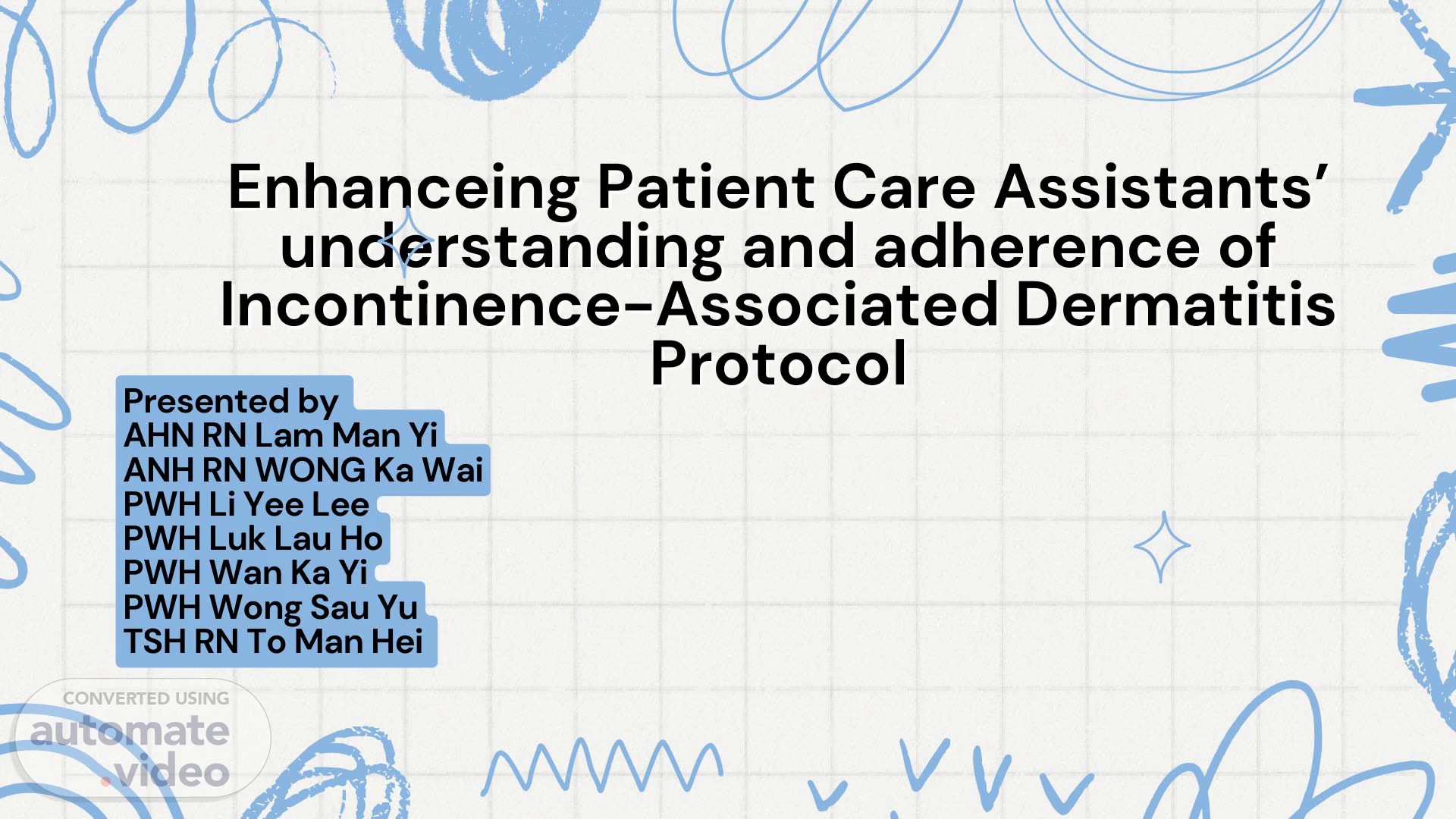
Enhancing Patient Care Assistants’ understanding and adherence of Incontinence-Associated Dermetitis Protocol
Scene 1 (0s)
Enhanceing Patient Enhanceing Patient Care Assistants’ Care Assistants’ understanding and adherence of understanding and adherence of Incontinence-Associated Dermatitis Incontinence-Associated Dermatitis Protocol Protocol Presented by AHN RN Lam Man Yi ANH RN WONG Ka Wai PWH Li Yee Lee PWH Luk Lau Ho PWH Wan Ka Yi PWH Wong Sau Yu TSH RN To Man Hei.
Scene 2 (13s)
What is Incontinence-Associated What is Incontinence-Associated Dermatitis (IAD) ? Dermatitis (IAD) ? Incontinence-associated dermatitis (IAD) is a common form of irritant contact dermatitis observed in geriatric patients who are exposed to urinary or fecal incontinence, or both (Gray et al., 2012)..
Scene 3 (27s)
Risk Factors in Elderly Risk Factors in Elderly Drier, thinner, more fragile skin Less resistant to infection Less surface sensory perception Incontinence (especially in cognitive impairment Daily use of restraints Poor nutrition Decreased immobility (especially in chair-bound and bed-bound) Less muscle tone.
Scene 4 (40s)
Other Contributing Facotors Other Contributing Facotors IAD may be associated with incorrect use of incontinence pads too high or too low absorbency incorrect fitting leakage or infrequent changes.
Scene 5 (50s)
Goals: Enhance PCAs’ understanding of IAD Improve PCAs adherence to the IAD protocol PCAs can apply suitable barrier creams and gentle cleansing during napkin rounds The Project Designand The Project Designand Planning Planning Improve health outcomes and ensure overall well-being and confort to patient Lower the incidence of IAD.
Scene 6 (1m 4s)
The Project Design The Project Design and Planning and Planning Assessment stage (2 weeks) Implementation stage (3 weeks) Two parts of pre-questionnaire: Questionnaire 1. Quiz 2. Education material 1. A cue card 2. Evaluation stage (2 weeks) Direct observation Post-questionnaire.
Scene 7 (1m 16s)
Assessment stage Assessment stage Two pre-questionnaires: Questions: assess the accessibility and interview their difficulties when following the guidelines 1. Quiz: assess their knowledge of IAD prevention and management 2. +DIRECT OBSERVATION 49 PCAs 21 napkin rounds.
Scene 8 (1m 27s)
Pre-questionnaire Pre-questionnaire 49 PCAs.
Scene 9 (1m 33s)
Direct Observation Direct Observation 21 napkin rounds In 6 medical wards Evaluated by.
Scene 10 (1m 40s)
Assessment Stage: Assessment Stage: Pre-questionnaire Pre-questionnaire Figure out the problems.
Scene 11 (1m 48s)
Assessment Stage: Assessment Stage: Pre-questionnaire Pre-questionnaire Figure out the problems Passed Failed 61% 39%.
Scene 12 (1m 56s)
Inform nurse when suspected an infection 60% Consistently Clean up during diaper changes 66% The use of appropriate cleansing products and techniques 71% Gentle dry the skin after cleansing 38% Apply skin protectant after cleansing 66% Unaware of the importance of avoiding the application of moisturiser onto over-hydrated skin 33% Assessment Stage: Assessment Stage: Direct Observation Direct Observation Figure out the problems.
Scene 13 (2m 12s)
Implementation Implementation Stage Stage Education Material.
Scene 14 (2m 18s)
Implementation Implementation Stage Stage Cue Card.
Scene 15 (2m 24s)
Evaluation Stage: Evaluation Stage: Post-questionnaire Post-questionnaire Passed Failed 74% 26%.
Scene 16 (2m 31s)
Evaluation Stage: Evaluation Stage: Post-questionnaire Post-questionnaire PCAs’ understanding of high-risk factors for IAD.
Scene 17 (2m 39s)
Evaluation Stage: Evaluation Stage: Post-questionnaire Post-questionnaire Awareness of the need for protective care measure.
Scene 18 (2m 47s)
Evaluation Stage: Evaluation Stage: Post-questionnaire Post-questionnaire Knowledge of recommended cleansing methods for incontinent patient.
Scene 19 (2m 56s)
Evaluation Stage: Evaluation Stage: Post-questionnaire Post-questionnaire Knowledge of appropriate skin protectant creams.
Scene 20 (3m 3s)
Inform nurse when suspected an infection 100% Consistently Clean up during diaper changes 100% The use of appropriate cleansing products and techniques 95% Gentle dry the skin after cleansing 95% Apply skin protectant after cleansing 95% Unaware of the importance of avoiding the application of moisturiser onto over-hydrated skin 90% Evaluation Stage: Evaluation Stage: Direct Observation Direct Observation.
Scene 21 (3m 19s)
Partially agree & Partially agree & strongly agree strongly agree 90% 90% Evaluation Stage: Evaluation Stage: Cue card Cue card.
Scene 22 (3m 28s)
Limitation Limitation Limited the number of PCAs ∵ two group members are in same ward might affect the representiveness Group members come from different hospitals Different resources of managing IAD.
Scene 23 (3m 38s)
IAD is not an inevitable skin condition found in elderly patients The performance and knowledge of PCAs on IAD care has a significant improvement after the education. Conculsion Conculsion reduce the prevalence and complications of IAD.
Scene 24 (3m 50s)
Q&A Q&A.
Scene 25 (3m 55s)
Thank you Thank you very much! very much!.